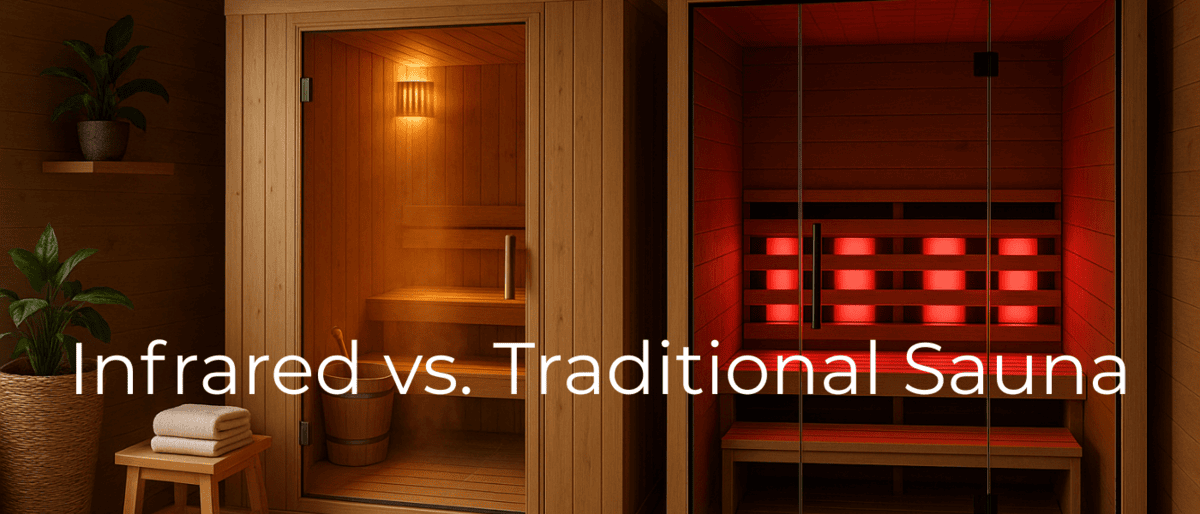When it comes to heat therapy, infrared saunas vs. traditional saunas is a hot debate, particularly when health benefits are the focus.
Both help with detoxification, muscle recovery, and relaxation. But, each one works differently and leave distinct results.
To help you understand which type of sauna suits your wellness goals, we’ve pulled everything you need to know about infrared and traditional saunas here.
Infrared Sauna vs. Traditional Sauna: Quick Comparison
Before we dive deeper into each sauna type, let’s take a quick look at how they stack up side by side.
This comparison chart highlights the key differences, such as heat source, energy use, and safety considerations. This way, you can take a quick look at which option aligns better with your needs.

What is a Traditional Sauna?
A traditional sauna heats the air using stones, wood, or electric heaters. This hot air warms your body through convection, creating a deep sweat.
Traditional saunas originated in Finland over 2,000 years ago as wood-fired smoke huts used for cleansing, healing, and social rituals. Early versions, called savusauna, had no chimneys. Smoke filled the space and was vented before use.
As designs modernised, electric heaters replaced open fires. Yet the core tradition of using dry heat for relaxation and wellness remains unchanged.
Today, traditional saunas are valued worldwide for their intense warmth and time-honoured health benefits.
Key Benefits of Traditional Saunas
- Detoxification: Sweating opens pores and flushes toxins.
- Cardiovascular Boost: Heat mimics light exercise, raising heart rate.
- Immune Support: Stimulates white blood cell production.
- Pain Relief: Soothes sore muscles and joints.
- Relaxation: Reduces cortisol (the stress hormone) and boosts dopamine.
What is an Infrared Sauna?
An infrared sauna uses infrared light to heat your body directly. The air remains cooler, but the heat penetrates deeper into muscles and tissues.
Key Benefits of Infrared Saunas
- Deeper Detox: Encourages sweat at lower temps for longer, gentler sessions.
- Metabolism Kickstart: Raises core temperature and promotes fat burn.
- Improved Circulation: Eases muscle soreness and helps recovery.
- Skin Benefits: Enhances collagen production and improves tone.
- Mental Clarity: Supports brain health and mood by reducing cortisol.

Who Should Avoid Saunas?
While saunas may have health benefits to boot, it’s simply not suitable for everyone. Infrared saunas may be more tolerable for some people but it’s important to follow prescribed use and guidelines at all times.
If you have the following conditions, make sure to consult with a healthcare provider before using a sauna:
- Heart disease (especially unstable angina or severe valve conditions)
- Recent heart attack
- Low blood pressure
- Respiratory issues (especially in high heat or humidity)
Reminders for Safe Sauna Use
Take note of the following safety precautions when using either an infrared or traditional sauna:
- When using a sauna for the first time, start with 5 minutes and work your way up as you get more regular and accustomed to the heat.
- Do not exceed 20 minutes per session.
- Drink plenty of water before and after each sauna session.
- Refrain from taking alcohol before your sauna session.
- Listen to your body and immediately exit the sauna room if you feel dizzy or unwell.
Can You Use Both Infrared and Traditional Saunas?
An infrared sauna and a traditional sauna may be used alternately within a single session or, separately in different sessions.
Using both in combination has the potential to enhance the health benefits that can be derived from heat therapy.
Here’s a sample plan on how to use both types of saunas in combination:
- Spend between 15 to 20 minutes in each sauna type, using either type of sauna alternately for 2 to 3 times per week.
- Stay hydrated throughout each session.
- Rest in between to cool down and recover.
How to Choose the Right Sauna for You
When weighing which sauna could be better for you, there are several factors that could influence your ultimate choice – or, you can choose to use both in combination.
Consider your preferences and goals:
- Want intense heat and ritual? Go traditional.
- Prefer gentle, targeted heat? Try infrared.
- Looking to recover post-workout? Infrared may be more effective.
- Like the steam experience? Traditional wins here.
- Concerned about energy bills? Infrared uses less power.
Final Thoughts
When it comes to infrared sauna vs traditional sauna, there’s no wrong choice—just what’s right for you and your goals for using a sauna.
In general Traditional saunas work best for those who find intense heat soothing and more relaxing. Meanwhile, infrared saunas may work best for those who want to enjoy the health benefits that can be derived from saunas but can tolerate less heat and steam.
Both sauna types support recovery, relieve stress, improve skin health, and increase energy Using both in combination can intensify benefits and lets you make the most of what each type can offer.
Ready to take the next step? SDS Australia can help you go over your options before you buy a sauna.
Contact Us Today to speak to an expert and learn more about infrared vs. traditional saunas.
FAQs
Can I use a sauna if I have medical conditions?
Check with your doctor—especially if you have heart, respiratory, or heat-sensitive conditions, including eczema and psoriasis.
How often should I use a sauna?
2 to 4 times per week is ideal. Start with shorter sessions and increase as tolerated.
Which sauna burns more calories?
Both sauna types can elevate heart rate and burn calories.





